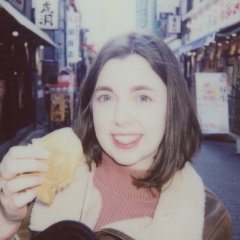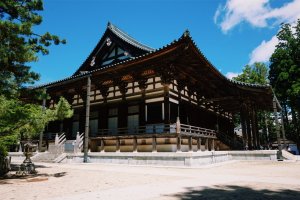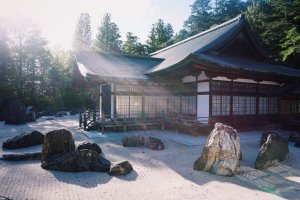Hidden high in the mountain tops among the lush and mysterious forests exists a spiritual world in Japan which feels very much alive. Mount Koya, or Koyasan as it is also known, is home to the origins of Shingon Buddhism and the spiritual teachings of Kobo Daishi, which have become a part of the land.
Climbing high into this mountainous region, it’s hard not to be astonished when you come face to face with the impressive Dai-mon gate, the entrance to the Koyasan area. The impressive structure, colored in bright vermillion red, creates a great impact against the blue sky and vibrant greens of the trees surrounding it. Once you enter through the gate, you are brought into the spiritual world of Danjo Garan Sacred Temple Complex. Filled with various temples, it is the first site where the founder Kobo Daishi started to build, with each structure holding a different purpose. It is said to be a physical representation of the spiritual world as described in the Womb Realm Mandala.

The most impressive of the structures was the iconic Konpon Daito, which stood proudly in brilliant white and red cladding against clear blue skies. Konpon Daito was very aptly built as a representation of the universe. Entrance is available into the Konpon Daito for at ¥200.
For full information about the other buildings included in the Danjo Garan Sacred Temple Complex, you can check out the official Kongobu-ji Head Temple website here (available in English, French and Japanese). For many of the temples, audio guides are available in multiple languages, with some temples also offering personal guided tours in English and Japanese. If you are planning on visiting all the spiritual sites in Koyasan, there is a combined ticket for entry to the temples which saves you a lot of money and time and allows you to explore without limitations.
The next stop you should make on your map is Kongobu-ji Head Temple, the central temple of Shingon Buddhism in Koyasan. The grand structure is home to many large halls where ceremonies took place. Each room is decorated with a different theme, including the Willow Room, the Betsuden which depicts the four seasons, and the Jodan-no-ma hall with walls coated in a stunning gold. Unsurprisingly this room is for hosting dignitaries, such as the Emperor, who would have visited in the past.

Outside of Kongobu-ji Head Temple you will find the largest rock garden in Japan surrounding a tea house used by the Royal family when they visit. The rock garden is said to be designed as a pair of dragons emerging from a sea of clouds. The contrast of the jagged grey stones trailing through the white gravel really does give the feeling of a magical being snaking around the tea house. Entrance to the Kongobu-ji Head Temple is ¥500 for adults and¥200 for children.
There is a third point of interest in Koyasan which you just cannot miss out on. It is Okuno-in, the last resting place of Kobo Daishi. Starting at the first bridge, Ichinohashi, you can follow the lantern lined pathway through the cemetery where many impressive tombstones stand between the ancient tree trunks. As moss creeps up on the surrounding tiered monuments inscribed with the five elements, you can hear the sound of the birds chirping high up above you in the branches of the trees. Most of these trees are over 500 years old and were planted by visitors from all over Japan, making this area unique in its range of plant life.
After passing two more bridges you reach Okuno-in. Here you can enter the Lantern Hall, an ornately decorated hall with a ceiling covered in warmly lit lanterns. This is the latest addition to the structure, with many donors participating in its construction. If you walk to the back of the temple you will find many people paying respects to Kobo Daishi’s mausoleum, where he is said to be in eternal meditation.
There is also a small tea house where pilgrims are able to have a cup of tea for free and take a rest before continuing their journey. But your experience in the cemetery doesn’t have to end there. A very unique night-time cemetery tour is available if you dare to join. The night time tour is really a highlight of the area, with the sombre stone lanterns lighting the trail, you can truly feel the mystery of the area come alive. On that note, keep an eye out for the flying squirrels who live overhead in the trees, and who like to scare the night-time tourists with their spontaneous appearances and screeching.
More information can be found on the Okuno-in Night Tour.
Temple stays at Koyasan
Great hospitality is the backbone of the Koyasan area, with 52 temples opening their doors to travelers. The temples all vary, offering many unique experiences which help you get the most out of your trip. One of these temples is Jofuku-in Temple which offers a comfortable experience for both solo and group travelers.
The rooms are traditional tatami style flooring decorated with beautiful artwork which embodies the spirituality of the temple. The sliding doors help bridge the gap between indoors and nature, with the second floor rooms overlooking a courtyard, creating a peaceful and harmonious experience. This particular temple stay offers a hot spring onsen bath, which is just what you need after a long day of sightseeing. Full amenities are offered, including a yukata gown which you are to free wear as you move between the public hot spring bath and your room; a small touch which immerses you in the rich culture.

Meals are also provided at the temple, most of them will follow the diet of the monks, offering a selection of vegetarian options for you to enjoy known as shojin-ryori. The meals are inspired by the area, often using local produce and seasonal vegetables, to make sure you get the tastiest meal to satisfy you. The strict vegetarian meal code is derived from the Buddhist belief that you should not harm or kill another being, since all beings are viewed as equal after they die. The preparation of such meals is also a part of the monks’ training program, helping them practice gratitude, patience and hospitality, with emphasis made on color balance and presentation.
So after a good night’s sleep, a soak in the bath and a nice wholesome meal, the next experience available to you is participation in the temple’s morning prayer. Usually starting around 6 am and lasting about 40 minutes, the morning prayer is conducted by the monks living in the temple. It’s a very spiritual start to your morning, bringing you closer to the Buddhist mantras which spreads into all aspects of the rich cultural area of Koyasan. While listening to the chanting of the monks, you are then invited to present incense to the Buddha and offer your prayers.

There is no pressure to join, with the morning prayer being an optional activity to attend, and since Buddhism welcomes all other religious beliefs to participate, you don’t need to be concerned about feeling out of place. The prayer room itself is beautifully decorated in ornate gold, with dimly lit warm lanterns, creating a very magical atmosphere that will stay with you long after your stay.
A matching service is available which hopes to pair travelers to their most suited temple; this allows you to make requests such as private bath facilities, dietary needs, etc. To access this service, you can apply at the official site.





























